Acoma Pueblo Black-on-white Mimbres Design Jar by Lucy Lewis - C3853F
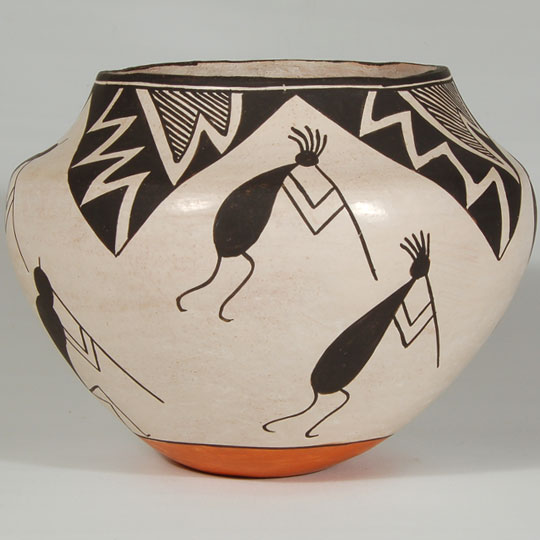 Lucy M. Lewis continued throughout her life to make pottery in the traditional way; digging and preparing clay, grinding potshards for temper; coiling the clay into a vessel shape, making her paints from plant and mineral elements, and firing the finished vessels in an open outdoor handmade kiln.
Lucy M. Lewis continued throughout her life to make pottery in the traditional way; digging and preparing clay, grinding potshards for temper; coiling the clay into a vessel shape, making her paints from plant and mineral elements, and firing the finished vessels in an open outdoor handmade kiln.
Frog Woman Hopi-Tewa Tall Cylindrical Jar (Paqua Naha) - C3853E
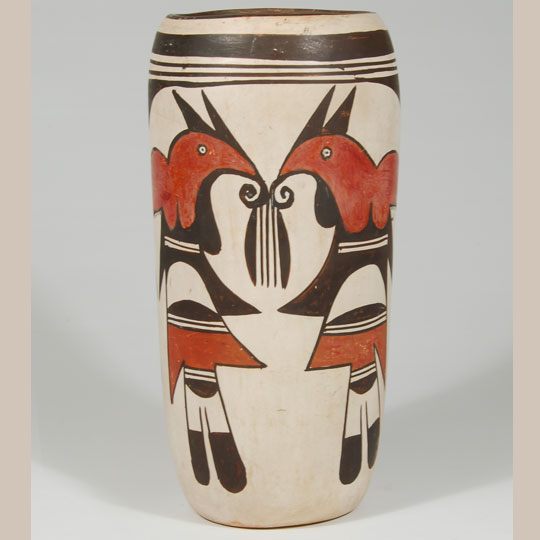 Frank Applegate conducted classes in the Hopi villages in 1922 at the request of the Indian Commission. It is quite possible that he re-introduced this shape to the Hopi potters at that time. The shape does have precedence from prehistoric times.
Frank Applegate conducted classes in the Hopi villages in 1922 at the request of the Indian Commission. It is quite possible that he re-introduced this shape to the Hopi potters at that time. The shape does have precedence from prehistoric times.
Recent studies of excavated prehistoric sites at Chaco Canyon have revealed specimens of cylindrical jars. Anthropologist Patricia Crown, from the University of New Mexico, and a colleague from the Hershey Center for Health and Nutrition, analyzed potsherds and found traces of a compound of cacao. From their research, they concluded that the cylindrical jars were used to hold chocolate in beverage form. Only a couple hundred complete jars have been found and most of them came from Pueblo Bonito, but many shards that would fit a cylindrical jar shape have been unearthed.
Mimbres Animals and Human Figures Painting by Tony Da - C3854
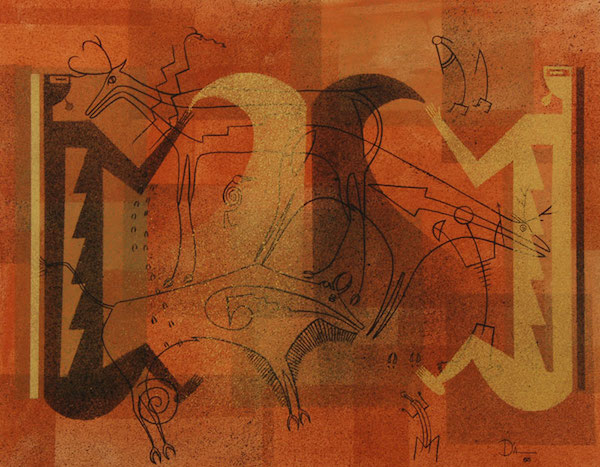 Tony Da was first a painter before becoming a potter. He began using casein paints in the 1950s and painted until he apprenticed to his grandmother, Maria Martinez, in the late 1960s. After 1972, he did very little painting and became a famous potter. Tony was enchanted with the art of the Mimbres Indians of New Mexico and many of his paintings reflect that interest.
Tony Da was first a painter before becoming a potter. He began using casein paints in the 1950s and painted until he apprenticed to his grandmother, Maria Martinez, in the late 1960s. After 1972, he did very little painting and became a famous potter. Tony was enchanted with the art of the Mimbres Indians of New Mexico and many of his paintings reflect that interest.
10-piece Santa Clara Pueblo Nacimiento Set by Margaret and Luther Gutierrez - C3855A
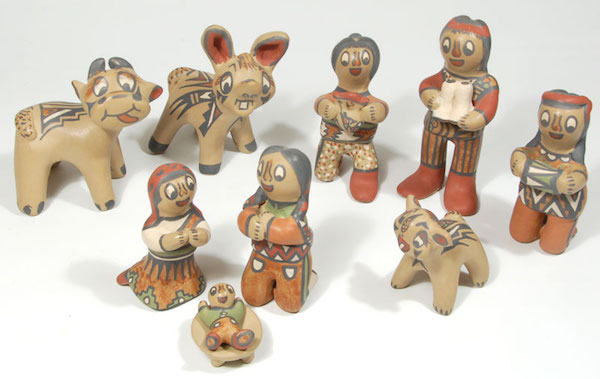 Whimsical, charming and delightful are just a few adjectives that could be used to describe this 10-piece nacimiento. Margaret and Luther Gutierrez were the children of Lela and Van Gutierrez, who continued the distinctive family style of making pottery using a variety of colors including red, tan, gold, blue, black, white and green pigments, all obtained from natural sources. It is only natural that they would have created a nacimiento because the family has long been known for the creation of figurines.
Whimsical, charming and delightful are just a few adjectives that could be used to describe this 10-piece nacimiento. Margaret and Luther Gutierrez were the children of Lela and Van Gutierrez, who continued the distinctive family style of making pottery using a variety of colors including red, tan, gold, blue, black, white and green pigments, all obtained from natural sources. It is only natural that they would have created a nacimiento because the family has long been known for the creation of figurines.
Original Painting “Zuni Fire Maker” by Kai-Sa (Percy Sandy) - C3851
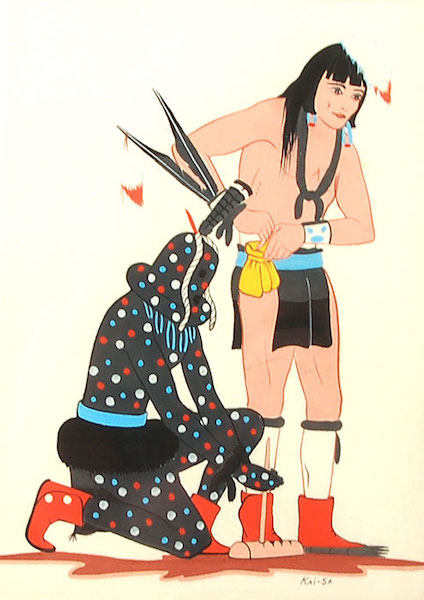 The Zuni Shulawitsi Katsina is almost an exact duplicate of the Hopi Kokosori, but he is not related to Kokosori. A young boy who is innocent and pure of heart usually performs him. He carries a fire stick, signifying his responsibility as caretaker of one of the important physical elements of the universe: fire. He is responsible for lighting fires before the Shalako ceremony prior to the winter solstice. The lighting of these fires is the signal for the Shalako to begin their ritual.
The Zuni Shulawitsi Katsina is almost an exact duplicate of the Hopi Kokosori, but he is not related to Kokosori. A young boy who is innocent and pure of heart usually performs him. He carries a fire stick, signifying his responsibility as caretaker of one of the important physical elements of the universe: fire. He is responsible for lighting fires before the Shalako ceremony prior to the winter solstice. The lighting of these fires is the signal for the Shalako to begin their ritual.
The Fire God is the black Katsina with colorful polka dots. I do not know the name of the assistant. The detail achieved by Kai-Sa is well beyond most paintings of this style. Each polka dot is precise. The skin tone of the assistant is smooth and evenly applied. This is certainly among the finest paintings by Kai-Sa
Large Santa Clara Pueblo Globular Black Bear Paw Jar by Toni Roller - C3853C
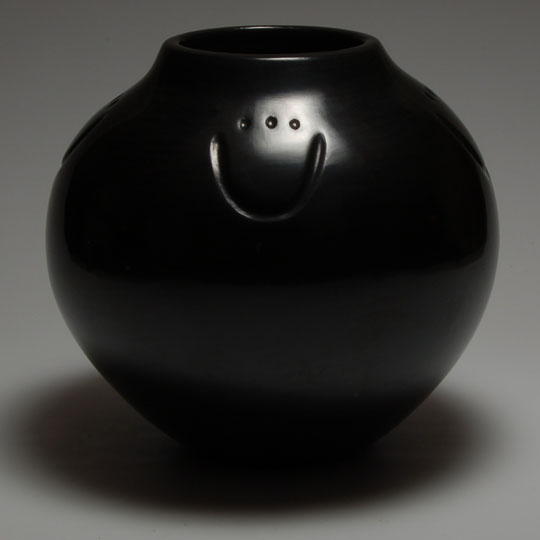 Toni Roller has always been a very traditionalist potter, following the strictest meaning of the word. She uses only traditional designs taught her by her mother, Margaret Tafoya. She also uses only traditional materials and firing techniques. This jar was constructed using coils and burnished with polishing stones. The design consists of four bear paw impressions near the rim.
Toni Roller has always been a very traditionalist potter, following the strictest meaning of the word. She uses only traditional designs taught her by her mother, Margaret Tafoya. She also uses only traditional materials and firing techniques. This jar was constructed using coils and burnished with polishing stones. The design consists of four bear paw impressions near the rim.
The burnishing of the entire Large Globular Black Bear Paw Jar is most exceptional and flawless. The firing produced a beautiful even black coloration. The jar is signed with the artist's name, pueblo name and is dated March 1997.
Original Tesuque Painting of a Forest Scene with Animals by Tim Vigil - C3823B
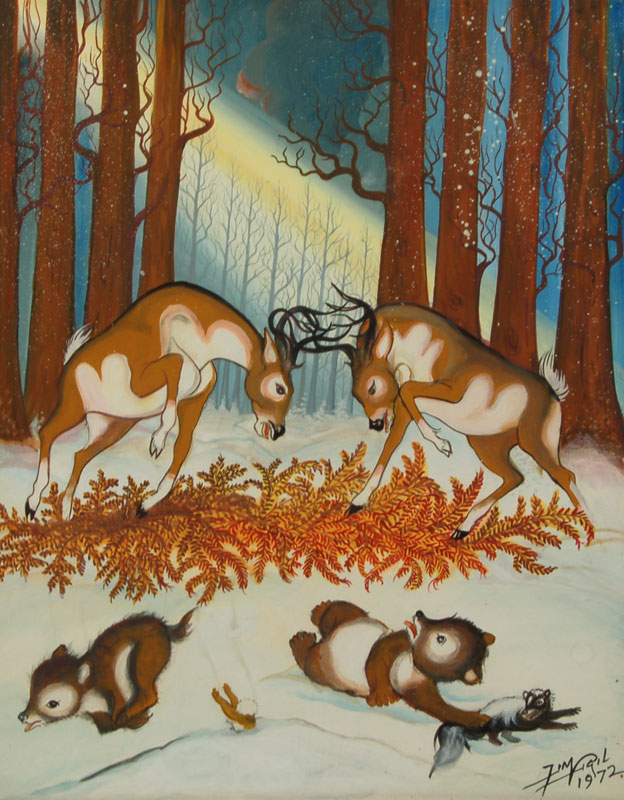 Tesuque Pueblo painter Tim Vigil passed away in 1972, but his age is not known at that time. He was the son of Thomas Vigil (c1889-1960), one of the earliest 20th century Pueblo painters, and the brother of Paul Vigil. Tim was not a prolific painter as he was employed full-time at Los Alamos National Laboratory.
Tesuque Pueblo painter Tim Vigil passed away in 1972, but his age is not known at that time. He was the son of Thomas Vigil (c1889-1960), one of the earliest 20th century Pueblo painters, and the brother of Paul Vigil. Tim was not a prolific painter as he was employed full-time at Los Alamos National Laboratory.
Hopi Sterling Silver Buckle with Man-in-the-Maze Design by Jason Takala - C3852F
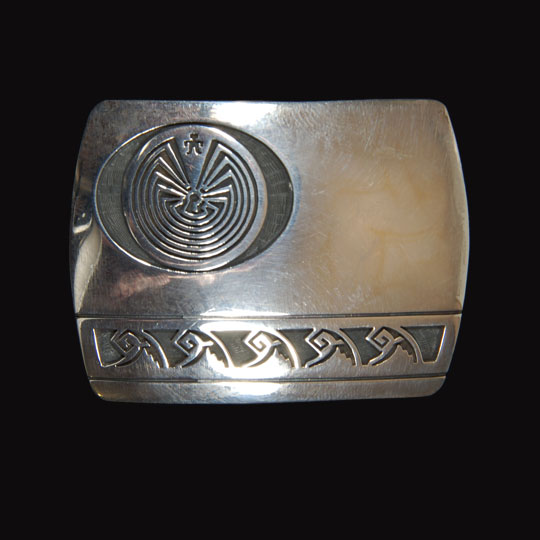 Hopi artisan Jason Takala has been an active jeweler since 1966. He is the nephew of Bernard Dawahoya and lives in the village of Shungopavi at Second Mesa. His favorite design is the Man-in-the-Maze, one of the most difficult because of the closeness of the cut-out design, a feat he does by hand. His more recent works are executed in both silver and gold
Hopi artisan Jason Takala has been an active jeweler since 1966. He is the nephew of Bernard Dawahoya and lives in the village of Shungopavi at Second Mesa. His favorite design is the Man-in-the-Maze, one of the most difficult because of the closeness of the cut-out design, a feat he does by hand. His more recent works are executed in both silver and gold
Navajo Sterling Silver Cast Buckle with Various Stones by Boyd Tsosie - C3852C
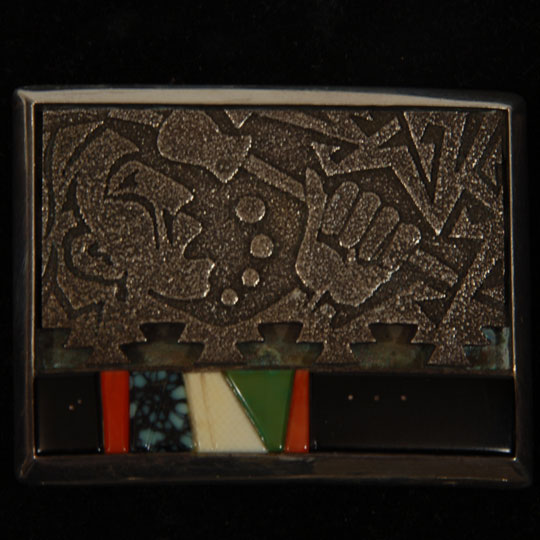 Navajo artisan Boyd Tsosie attended the Navajo Community College and studied under the tutelage of Kenneth Begay. He is considered a maker of fashion jewelry, departing from traditional styles of Navajo jewelry. He is an innovative designer and craftsman.
Navajo artisan Boyd Tsosie attended the Navajo Community College and studied under the tutelage of Kenneth Begay. He is considered a maker of fashion jewelry, departing from traditional styles of Navajo jewelry. He is an innovative designer and craftsman.
His jewelry creations were featured in "The New Look in Indian Jewelry" in Arizona Highways, April 1979. He was also included in the exhibit "Jewels of the Southwest" at the Museum of Indian Arts and Culture, Santa Fe.
San Ildefonso Pueblo Black-on-black Candle Holders by Maria Martinez - C3849A
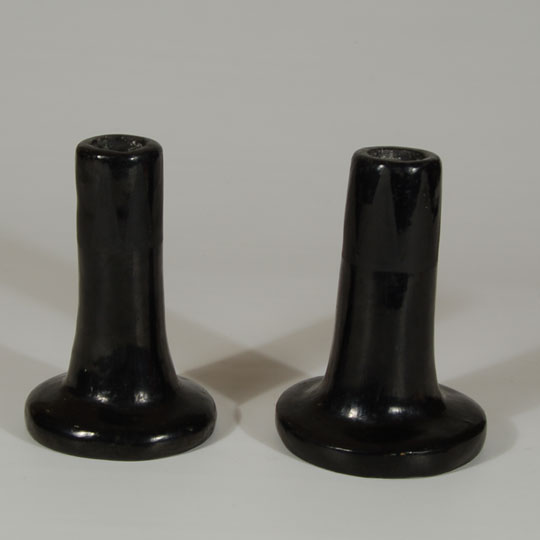 As published by Richard Spivey, Maria and Julian began producing plain polished black pottery around 1912 and Black-on-black pottery around 1919-1920. Julian continued to paint Maria's pottery until his untimely death in 1943. It was around 1925 that Julian's name began to appear alongside Maria's on their pottery. So, we see that there is only a period of about 18 years when the co-signed pottery was made.
As published by Richard Spivey, Maria and Julian began producing plain polished black pottery around 1912 and Black-on-black pottery around 1919-1920. Julian continued to paint Maria's pottery until his untimely death in 1943. It was around 1925 that Julian's name began to appear alongside Maria's on their pottery. So, we see that there is only a period of about 18 years when the co-signed pottery was made.
Hopi Pueblo Overlay Silver Hair Barrette by Bernard Dawahoya - C3833C
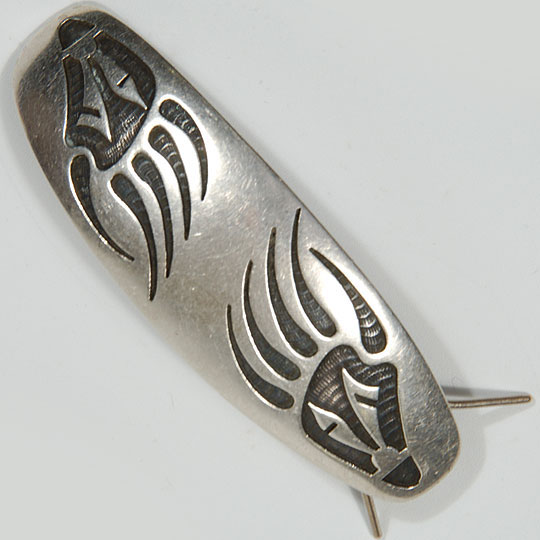 Bernard Dawahoya (b.1935-) Masqueva - Little Sun learned to make jewelry from his uncles, Washington Talayumptewa & Sidney Sekakuku. Bernard recalled that he was about 15 years old when he was working at his Uncle Sidney Sekakuku's sheep camp and was caught playing with his jewelry-making tools, so his uncle began teaching Bernard jewelry making at that time.
Bernard Dawahoya (b.1935-) Masqueva - Little Sun learned to make jewelry from his uncles, Washington Talayumptewa & Sidney Sekakuku. Bernard recalled that he was about 15 years old when he was working at his Uncle Sidney Sekakuku's sheep camp and was caught playing with his jewelry-making tools, so his uncle began teaching Bernard jewelry making at that time.
Original Zuni Pueblo Painting of “The Zuni Rain God” by Manuel Sandy - 25914
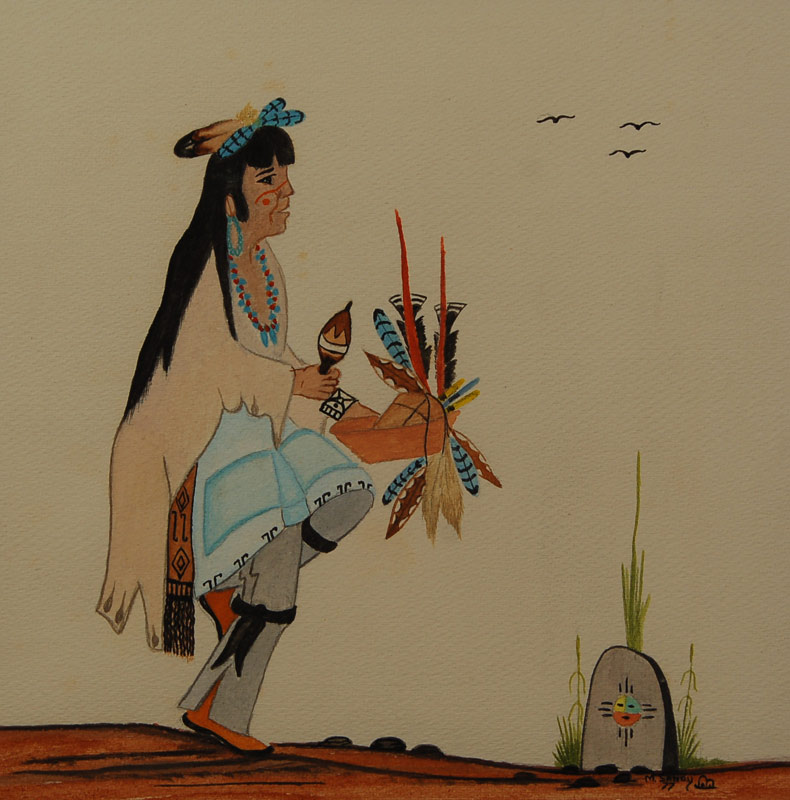 The painting is entitled "The Zuni Rain God" and is signed M. Sandy and dated 1977. It shows the Rain Priest with a medicine basket that holds a wrapped bundle with many colorful feathers. He is heading toward the religious shrine. Interestingly he is dressed in traditional Native clothing-the pants with the split up the side are traditional Hopi and Zuni cotton trousers that were made from hand woven cotton.
The painting is entitled "The Zuni Rain God" and is signed M. Sandy and dated 1977. It shows the Rain Priest with a medicine basket that holds a wrapped bundle with many colorful feathers. He is heading toward the religious shrine. Interestingly he is dressed in traditional Native clothing-the pants with the split up the side are traditional Hopi and Zuni cotton trousers that were made from hand woven cotton.
Large Hopi Pueblo Polished Red Wedding Vessel by Garnet Pavatea - 25913
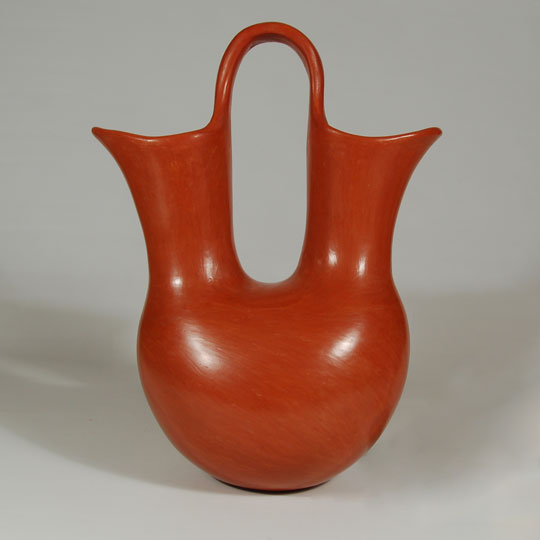 Garnet Pavatea (1915-1981) Flower Girl was a long-time entrant in the craft exhibit and won many awards by doing so. She also seemed to be a favorite of the Museum of Northern Arizona. She was often a demonstrator at the Craftsman Exhibition. For a number of years, Adobe Gallery had a standing order from the Museum of Northern Arizona for any Garnet Pavatea pottery available.
Garnet Pavatea (1915-1981) Flower Girl was a long-time entrant in the craft exhibit and won many awards by doing so. She also seemed to be a favorite of the Museum of Northern Arizona. She was often a demonstrator at the Craftsman Exhibition. For a number of years, Adobe Gallery had a standing order from the Museum of Northern Arizona for any Garnet Pavatea pottery available.
This large stone-polished red wedding vessel has a beautiful, smooth, highly-burnished finish. It is completely devoid of painted designs. She extended the polishing down into the interior of the vessel, a step that was not necessary but that demonstrates her attention to detail.
14 Piece Taos Pueblo Nacimiento Set by Alma Loretto Concha - 00230
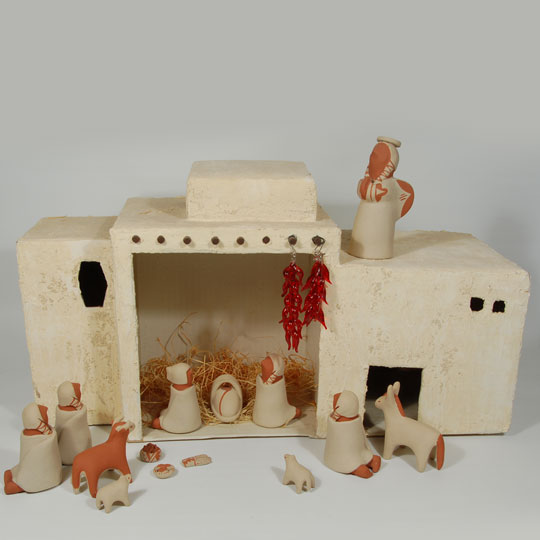 Alma Loretto Concha (1941 - ) was originally from Jemez Pueblo but moved to Taos Pueblo when she married. At the time that she made this nacimiento, in 1978, she was a resident of Taos Pueblo. This set includes the Holy Family, Three Kings with their gifts of corn, bread and chile, four animals and an angel.
Alma Loretto Concha (1941 - ) was originally from Jemez Pueblo but moved to Taos Pueblo when she married. At the time that she made this nacimiento, in 1978, she was a resident of Taos Pueblo. This set includes the Holy Family, Three Kings with their gifts of corn, bread and chile, four animals and an angel.
Historic Hopi Pueblo Cylindrical Polychrome Jar with Avian Designs - 25407
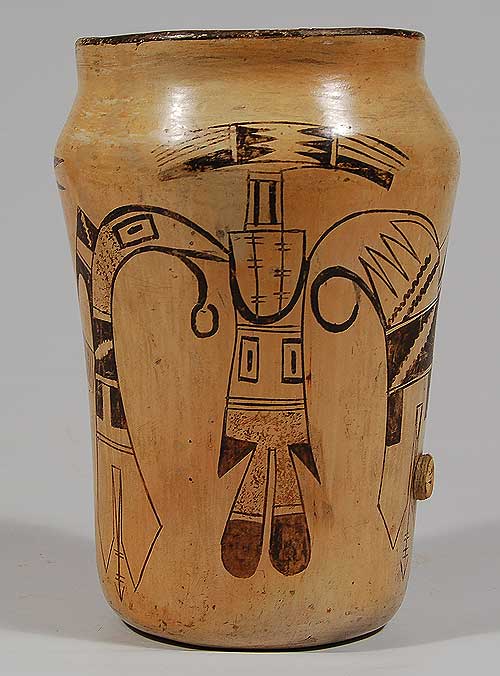 Frank Applegate conducted classes in the Hopi villages in 1922 at the request of the Indian Commission. It is quite possible that he re-introduced this shape to the Hopi potters at that time. The shape does have precedence from prehistoric times.
Frank Applegate conducted classes in the Hopi villages in 1922 at the request of the Indian Commission. It is quite possible that he re-introduced this shape to the Hopi potters at that time. The shape does have precedence from prehistoric times.
Recent studies of excavated prehistoric sites at Chaco Canyon have revealed specimens of cylindrical jars. Anthropologist Patricia Crown, from the University of New Mexico, and a colleague from the Hershey Center for Health and Nutrition, analyzed potsherds and found traces of a compound of cacao. From their research, they concluded that the cylindrical jars were used to hold chocolate in beverage form. Only a couple hundred complete jars have been found and most of them came from Pueblo Bonito, but many shards that would fit a cylindrical jar shape have been unearthed.
Very Large Ohkay Owingeh ( San Juan) Pueblo Black over Gray Storage Jar - C3215A
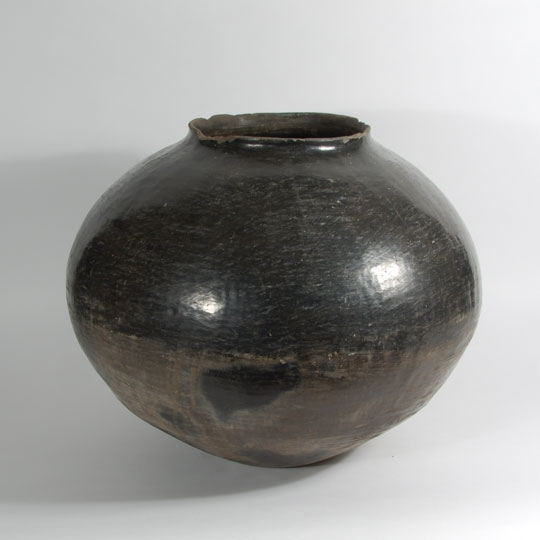 The pre-1900s vessels from Ohkay Owingeh were not as highly polished as today's blackware from the other Tewa pueblos, but the lack of severe polishing provided slight irregularities in the surface of a vessel from which the reflected light is pleasantly muted. Most vessels were slipped with a deep red slip on the upper 2/3rd of the body, leaving the lower 1/3rd without slip. The entire vessel was then polished, inside and out, to a hard finish. The red-over-tan finished product was then fired-either in an oxidizing or reduction firing-from which would be obtained a red-over-tan or black-over gray finished product.
The pre-1900s vessels from Ohkay Owingeh were not as highly polished as today's blackware from the other Tewa pueblos, but the lack of severe polishing provided slight irregularities in the surface of a vessel from which the reflected light is pleasantly muted. Most vessels were slipped with a deep red slip on the upper 2/3rd of the body, leaving the lower 1/3rd without slip. The entire vessel was then polished, inside and out, to a hard finish. The red-over-tan finished product was then fired-either in an oxidizing or reduction firing-from which would be obtained a red-over-tan or black-over gray finished product.
Very Large Historic Kiua Polychrome-Cochiti Variety-Storage Jar - 22257
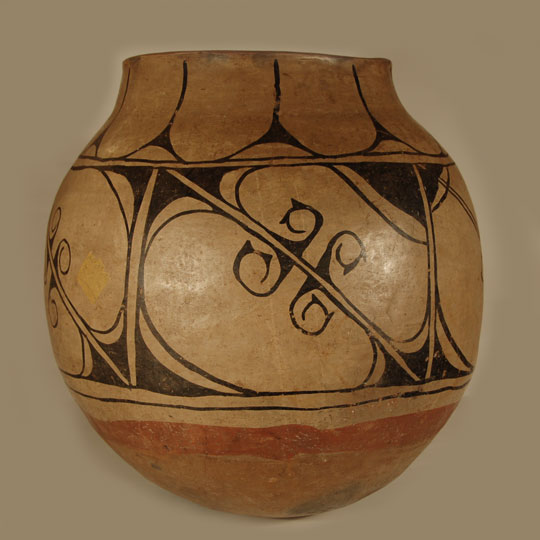 Cochiti Pueblo residents speak the Keresan language, along with their Northeast Keres neighbors, Kewa and San Felipe. The three pueblos are strongly religious in both the Roman Catholic and their own Native religion. Their association with non-native peoples is not as homogenous, however. Kewa is more conservative in protecting its beliefs and lifestyle that either Cochiti or San Felipe. Cochiti is more open about painting religious symbolism on secular pots whereas Kewa would not do so. San Felipe is located closer to Interstate 25 than Cochiti and operates a casino open to the public.
Cochiti Pueblo residents speak the Keresan language, along with their Northeast Keres neighbors, Kewa and San Felipe. The three pueblos are strongly religious in both the Roman Catholic and their own Native religion. Their association with non-native peoples is not as homogenous, however. Kewa is more conservative in protecting its beliefs and lifestyle that either Cochiti or San Felipe. Cochiti is more open about painting religious symbolism on secular pots whereas Kewa would not do so. San Felipe is located closer to Interstate 25 than Cochiti and operates a casino open to the public.
Cochiti Pueblo has been in its present location since before 1700. Its current population is around 1500. It has a long history of producing beautiful pottery for use at the pueblo and for producing large quantities of figurine pottery for sale to merchants in Santa Fe. The potters seem to be better known for the figurine pottery than for vessel-shape pottery, but the latter has always been produced for pueblo use as well as for sale.
Jar Inspired by Work of Grace Chapella by Mark Tahbo - 25912
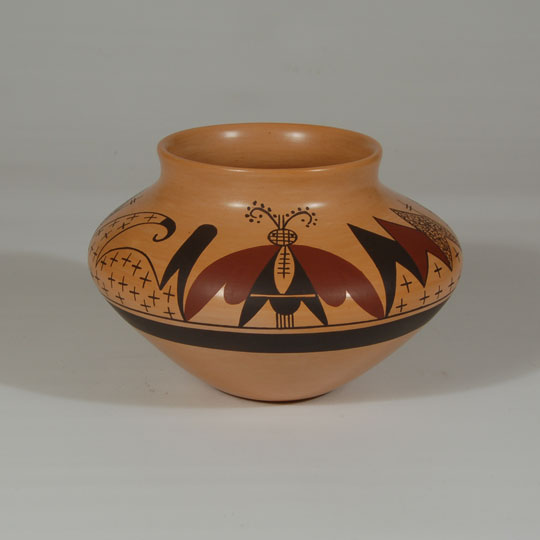 Mark Tahbo's great-grandmother was Grace Chapella and his grandmother was Alma Chapella Tahbo. Mark remembers Grace because she encouraged him to work with clay when he was a youngster. Mark was around 22 years old when Grace passed away at the age of 107 years. Mark reminisced about Grace when he brought us this jar. He said that when she was about 104 years she made a jar about the size of this one he brought us and it was the largest jar she had made in years and years, so her daughter, Alma hid it from Grace so she would not break it or ruin it by painting the design. Grace searched and searched for the jar and finally found it hidden behind a door in a stove. She took it out and held it while sitting in a chair and fell asleep with it in her lap. Of course, it fell to the floor and broke in many pieces. She awoke and said that Alma is going to be very angry at her, which, of course, was the case.
Mark Tahbo's great-grandmother was Grace Chapella and his grandmother was Alma Chapella Tahbo. Mark remembers Grace because she encouraged him to work with clay when he was a youngster. Mark was around 22 years old when Grace passed away at the age of 107 years. Mark reminisced about Grace when he brought us this jar. He said that when she was about 104 years she made a jar about the size of this one he brought us and it was the largest jar she had made in years and years, so her daughter, Alma hid it from Grace so she would not break it or ruin it by painting the design. Grace searched and searched for the jar and finally found it hidden behind a door in a stove. She took it out and held it while sitting in a chair and fell asleep with it in her lap. Of course, it fell to the floor and broke in many pieces. She awoke and said that Alma is going to be very angry at her, which, of course, was the case.
Historic Large Polychrome Acoma Pueblo Water Jar - 25136
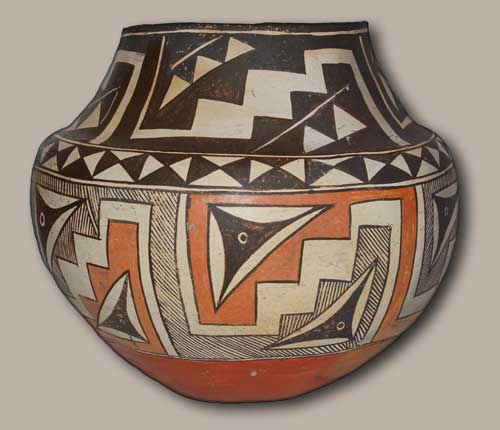 This polychrome olla qualifies as an exceptional work of art. The vessel shape is as near perfect as one would expect. The high shoulder provided room for a large area on the main body for the artist to express her artistic talent.
This polychrome olla qualifies as an exceptional work of art. The vessel shape is as near perfect as one would expect. The high shoulder provided room for a large area on the main body for the artist to express her artistic talent.
As is traditional at Acoma, the jar was formed in native clay with ground pottery shard temper, has a rag-wiped white slip, red neck interior, and red-slipped underbody with concave base. The point of maximum diameter is as near the equator of the jar as one could calculate.
Historic Acoma Pueblo Large Polychrome Olla - C3671F
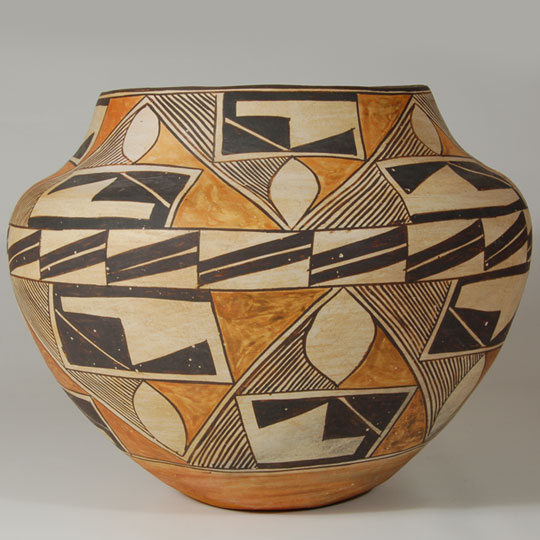 The high shoulder of this historic jar is emphasized by the split horizontal bars that are stacked on each other. The strong black of this design contrasts significantly with the polychrome designs on the neck and body of the Acoma Pueblo jar.
The high shoulder of this historic jar is emphasized by the split horizontal bars that are stacked on each other. The strong black of this design contrasts significantly with the polychrome designs on the neck and body of the Acoma Pueblo jar.
The neck design contains the same design elements as those on the body, just reduced in size to fit the smaller area. The design panels are divided by triangles alternating in an up and down position. In each triangle there is a white and black design in a horizontal rectangle. On one side of that is a design of fine black parallel lines and on the other side is a block of orange. This design within a triangle is repeated throughout the body and neck.

